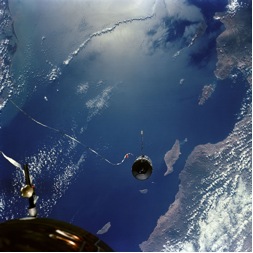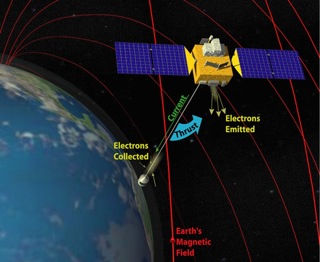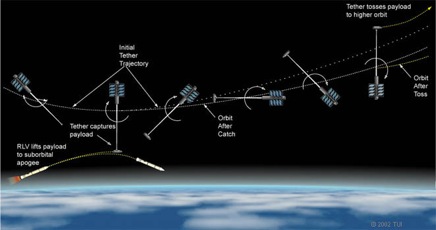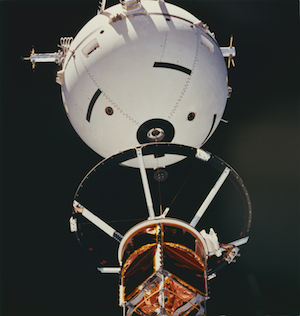Les Johnson
When science fiction author Arthur C. Clarke popularized the notion of taking an elevator from the surface of the Earth into space in his novel The Fountains of Paradise (1979), he thrust the idea into the heads of a generation of space scientists and engineers then in primary school who now dream of rocketless transportation to space in clean, environmentally-friendly elevators spread across the world’s equator. Numerous conceptual designs for such an elevator now exist, technical conferences at which engineers discuss the technical challenges associated with building them meet regularly, and a series of space flights have demonstrated that flying long cables in space (some over twelve miles long) is possible. Where is all this taking us and will we have a space elevator anytime soon? The questions are, unfortunately, not easy to answer. We’ll begin with an important first step: space tethers.
A space tether is simply a cable, or wire, that flies in space to connect spacecraft, provide power, or produce propulsion. The idea isn’t new and there have been several tethers flown in space since the 1960’s. NASA’s Gemini XI (1966), piloted by astronauts Pete Conrad and Richard Gordon, used a parachute cable to attach their Gemini spacecraft to an Agena expended rocket stage to demonstrate tethered formation flight and, after spinning up the now-combined vehicles, the world’s first space-based artificial gravity testbed. (In Earth orbit, astronauts experience weightlessness not because the Earth’s gravity has decreased to zero, but because the orbital angular acceleration of their mass causes a net force that exactly cancels the gravitation acceleration of the Earth, with the net gravity they experience reduced to nearly zero–hence the term, “weightless.” This is also the reason they remain in orbit and don’t fall all the way to the ground, a significant fact not to be forgotten when we discuss space tethers that extend to altitudes less than geosynchronous.) No significant scientific measurements were made and the demonstration was largely forgotten as the Apollo Program moved into high gear, leading to Neil Armstrong’s historic flight in 1969. The Gemini and Agena tethered spacecraft system was photographed in space and can be seen in Figure 1.
Figure 1. The Agena rocket stage shown tethered
to the Gemini XI spacecraft in Earth orbit.
(Image courtesy of NASA.)
Space tethers are potentially useful in many ways: for propulsion, power, formation flying, and the production of artificial gravity.
A long wire tether can produce and conduct electricity by interacting with the Earth’s magnetic field and ionosphere. Consider how electrical power is generated on Earth: a wire is moved rapidly through a magnetic field, producing a voltage across the wire that then accelerates electrons, causing an electrical current to form and flow through the wire. In an earthly power plant generator, the wire is coiled and rotated relative to a magnet by either steam, falling water, or wind power. On the ground, there is no shortage of electrons to be collected and turned into electrical current and our lights go on with the flick of a switch as the electricity generated by our local utility is metered and sold to consumers day and night. The same principle can be used in space to generate power, but instead of a big stationary magnet, the Earth’s magnetic field is used, which looks essentially like a huge bar magnet with north and south poles. Electrons are captured from the diffuse plasma (a mixture of charged particles, including free electrons and protons) surrounding the Earth called the ionosphere, and flow through a long wire deployed from a spacecraft in orbit. The wire, which is kept mostly taut and pointed toward the center of the Earth by the slight difference in the Earth’s gravitational attraction at each end, has a voltage across it produced by its motion relative to the Earth’s magnetic field. One end of the wire is positively charged, the other negatively. The free electrons in the Earth’s ionosphere are negatively charged so they are attracted to the positive end of the tether and can flow through it, forming an electrical current.
Those familiar with electrical circuits may now ask, “Whoa…what closes the circuit so that the current can flow? There’s no wire loop, or circuit, along a wire deployed in space.” (You close an electrical circuit every time you turn on a light, power up your computer, or start an electric drill.) The answer is quite unexpected: the circuit is “closed” by the ionospheric plasma itself. Plasmas are inherently electrically conductive and the electrons will flow from the wire into the plasma with only a little “help” from us humans in the form of an electron gun or some other sort of plasma contactor. The end result is the same–an electrical current is generated in the wire that can be used to power a spacecraft and its payload. And it can be a lot of power–kilowatts of power in a wire tether just a few miles long. (Don’t panic at the thought of a wire tether in space that’s miles long. We’ve flown tethers over ten miles long without a hitch!).
But there’s more. Our power generating wire tether also provides propulsion. Propulsion is generated via the force a magnetic field exerts on a wire carrying an electrical current. The force acts in a direction perpendicular to both the direction of current flow and the magnetic field. The resulting tether propulsion system is just a way of getting an electrical current to flow in a long orbiting wire (the tether) so that the Earth’s magnetic field will accelerate the wire and, consequently, the payload attached to the wire. The direction of current flow in the tether, either toward or away from the Earth along the local vertical, determines whether the magnetic force will raise or lower the orbit. The tethered system extracts electrons from the ionospheric plasma at one end (upper or lower, depending upon the deployment direction and intended thrust motion) and then carries them through the tether to the other end, where they are returned to the plasma. The circuit is completed by currents in the plasma as shown in Figure 2. This concept will work near any planet with a magnetosphere–which includes the Earth, Saturn, and Jupiter. Unfortunately, it will not work in high Earth orbit or in deep space–there is no ionosphere from which it can collect plentiful electrons and deep space offers no strong magnetic field to exploit (and also very few charged particles).
The beauty of the system is that it requires no propellant or other expendable. The tether can produce power and propulsion essentially indefinitely, without running out of fuel.
Figure 2. Electrodynamic tethers use the Lorentz force to create thrust.
(Image courtesy of Tethers Unlimited, Inc.)
A space tug boat can be built using electrodynamic tethers and used essentially indefinitely. This would be like building a fleet of moving trucks that never need refueling. Such a tug could rendezvous with a payload sent to space by rocket or rocket plane, grapple it, move the payload to its desired orbit, and then return to a lower altitude to begin the process over again. All of this accomplished using only the energy derived from the Earth’s magnetic field and sunlight. It is worth noting that electrodynamic tether propulsion systems will take considerably longer to adjust a spacecraft’s orbit than a traditional chemical rocket. That’s because it provides a very small but continuous thrust force rather than a large push-you-back-in-your-seat high thrust that is over in a few minutes when all the fuel runs out. Tethers aren’t for everything–if you have to get somewhere quickly, then a rocket is probably a better choice. If you can take a while to get from orbit “a” to orbit “b,” and you want to do so efficiently, then a tether is a far better solution.
But wait, the Earth isn’t the only planet with a magnetic field and ionosphere. If you take a tether generating kilowatts of power in Earth orbit and transport it to Jupiter, it will quickly burn out and briefly become the brightest fuse in the solar system–generating megawatts of power. Why? Because the Jovian magnetic field is dramatically stronger than Earth’s. This, coupled with the plasma environment surrounding the planet, make it ideal for electrodynamic tether power and propulsion. A tethered spacecraft there could continuously generate megawatts of power and simultaneously propel itself to virtually any destination in Jupiter’s orbit without fuel. The same system could also be used to slow down a spacecraft arriving at Jupiter from Earth, using only electromagnetic forces to brake into orbit. No rocket engines are required.
Combining electrodynamic tether propulsion for braking with a solar sail offers a completely propellantless method of getting from Earth orbit to Jupiter.
Coming back to Earth, and that’s where the first generation of space tethers will be used, there are limits to what they can do. The system won’t work at altitudes below about 180 miles due to the increased atmospheric drag (from the atmosphere getting denser). Although these tethers are only 0.1 inches wide, they are miles long, giving them a cross sectional area of several square feet. That’s a lot of area to cause drag. (Drive down the road with your hand out the window and turn it face up. The force pushing your hand backward is the type of drag that tether system will experience as it flies closer to the Earth.) The system also won’t work well at altitudes above 1500 miles because the gas density is too low–there is no longer enough plasma to close the circuit and create current. No current means no power and no thrust.
For sending payloads to higher orbits, or into interplanetary space, we can think about using momentum exchange tethers as the obvious next step. If you are like me, when you were young and played with a yo-yo, after a fashion, you got bored making it go up and down. What, then, did you do with it? You most likely turned it into a sling shot by twirling it over your head and letting it go. With luck, as it flew off in whatever direction it was aimed, no windows were broken and no one was bruised. Momentum exchange tethers work in exactly the same way. Only instead of a yo-yo with a string a few feet long, these tethers systems are up to a 100 miles long and they can send spacecraft careening off to higher Earth orbits or beyond–like to the outer planets and beyond.
NASA studied these systems in the 1990’s and 2000’s, and even came up with a few ideas for systems that might allow for propellantless (no fuel) transfer between the Earth and the Moon, with Mars and other deep space destinations. An artist’s concept of this technology can be seen in Figure 3. NASA created an awesome video showing how such a system might operate; the video is now on YouTube.
Figure 3. Momentum Exchange tethers could use brute force to sling
payloads from low Earth orbit to virtually anywhere in the solar system.
(Image courtesy of Tethers Unlimited, Inc.)
The late scientist and science fiction author Dr. Robert Forward proposed a system of these rotating tether stations that could send spacecraft and other payloads from Earth orbit to the surface of the Moon, and back again, using only a minimal amount of propellant. Recall the Moon has no atmosphere and therefore the tether system will not experience any atmospheric drag. Creative orbital placement will therefore allow the tether tip to reach from lunar orbit all the way to the surface of the Moon to deposit or pick up a payload. The payload picked up at the Moon could then be sent, via a sling-shot motion, back to Earth or to another destination as needed–perhaps in a Geostationary Earth Orbit to support the construction of space solar power stations.
Technically astute readers may wonder how these systems can spin up, throw a payload, and then be reused to repeat the process indefinitely. All of these steps require energy and nature doesn’t give us free lunches when it comes to conserving things like momentum and energy. That’s where electrodynamic tethers come in. These long, spinning tether systems are made from electrically conductive materials that derive their energy from the Earth’s magnetic field and ionosphere, giving them what amounts to be a virtual “free lunch,” with the energy (again) coming from sunlight and the system’s orbital mechanics. But what about the rotating tether system at the Moon? The Moon has no magnetic field nor does it have an ionosphere. How, then, can an electrodynamic tether work there? It cannot. Instead, the Lunar tether system will use highly efficient solar electric propulsion to spin up and recover energy from previous “throws” by catching incoming payloads, each of which is arriving with substantial excess orbital energy that can be converted into the tether system’s altitude or spin rate during the catch. The lunar system isn’t really propellantless, just almost so. Even then, it is far more efficient and reusable than any rocket system currently envisioned.
Another innovative tether propulsion idea is sometimes called the Elevator to Space. Imagine a non-rotating tether, not necessarily conductive, that stretches from Low Earth Orbit upward several thousand miles to a platform at a higher altitude, perhaps eventually extending all the way to GEO. Now imagine a rocket flying to the lower platform, docking, and transferring its cargo to an elevator that runs up and down the length of tether connecting the two platforms. With the whole system powered by electricity from sunlight, we would now have a space elevator to inexpensively transfer people and cargo from near the surface of the Earth to GEO and beyond. Not only would such a system have extreme reusability, making the cost per trip low, but it would operate using electrical power, with which we are very efficient, driving the costs even lower.
Better yet, we would have an “almost space elevator” that is missing only the portion from the lower platform to the surface of the Earth, and this brings us full circle to The Fountains of Paradise.
A space elevator is envisioned to be a tether extending from the surface of the Earth, originating somewhere along the equator, all the way to beyond Geostationary Earth Orbit (>22,000 miles) where the other end is anchored to a fairly massive body such as a small asteroid. The tether is kept taut by the centrifugal forces caused by the Earth’s rotation. Attach an electrically powered elevator and off you go–taking payloads and people from the surface of the Earth to space with the ease of boarding the elevator at The Empire State Building.
The challenges of building such an elevator are many–too many to describe in detail here. They include:
- Manufacturing high strength materials from which the whole structure must be made
- Building or capturing the mass that must be attached to the upper end of the elevator tether
- Ensuring safety to prevent a planetary disaster if the tether somehow breaks and falls to the ground, over thousands of miles of surface stretching nearly all the way across the planet
- Giving up Earth orbiting spacecraft–almost all spacecraft in Earth orbit cross the equatorial plane, which includes the plane in which the space elevator is constructed. This means they each have a small, but non-zero chance of colliding with the space elevator each time they circle the Earth. If you consider all the orbital debris already in Earth orbit (see my Baen essay, “Living Without Satellites”), then there are nearly half a million objects that pose a collision risk multiple times each day. The concern is that any such elevator will first require that we remove all the debris already circling the planet and that we remove all the active spacecraft there. Overall, this may be worth it for the benefits to be gained from having safe, clean and rapid access to space. But that is still to be determined...
Do I believe we will ever have the capability to build a space elevator? Yes. Should we build one? Maybe not. It is inconceivable to me that we will ever want to give up the flexibility of having satellites orbiting the Earth. Unless someone finds a way to make an elevator impervious to damage when something moving at about 16,000 miles per hour (like an orbiting spacecraft) hits it, then I just cannot imagine it will ever be practical–at the Earth.
Building a lunar space elevator makes a great deal of sense. Given the much smaller lunar gravity, the materials with the strength required to build one are essentially available today. That doesn’t mean there aren’t engineering challenges: the Moon’s slow rotation will require building a much longer tether than is required at the Earth in order to provide the necessary ballast–over 30,000 miles. For comparison, the circumference of the Earth is approximately 25,000 miles. This would be a long tether indeed–but doable. A Mars elevator is also possible. In fact, it should be possible to build such elevators on virtually any planetary body.
Other than a few suborbital missions, not much happened in space tether technology development after the Gemini XI flight until the early 1990’s, which saw a flurry of missions, leading many advocates to believe that the day of flying missions using tethers for power and propulsion was finally at hand. Alas, this was not to be.
The best known space tether mission was conducted by the United States in partnership with Italy aboard the Space Shuttle Atlantis in 1992. The Tethered Satellite System was an ambitious mission whose goal was to study the behavior of an electrodynamic tether in the Earth’s ionosphere and its interactions there. This joint USA/Italy collaboration was to deploy a 1000-pound instrumented end mass spacecraft to a distance of 12 miles upward from the Space Shuttle and use it to generate one kilowatt of electrical power. A last-minute design change in the deployer system resulted in a deployment failure in which the tether stopped deploying only 840 feet away from the Orbiter (Figure 4). Fortunately, the astronauts were able to retrieve the tethered end mass and return it to the Earth for refurbishment. The system flew again in 1996 and almost reached its full 12-mile tether deployment before another engineering design failure led to the tether being severed–ending the mission. Before it broke, the Tethered Satellite System did successfully demonstrate that a conducting tether can generate more than one kilowatt of power by its interaction with the Earth’s near space environment.
Figure 4. NASA’s Tethered Satellite System mission was to deploy a 12 mile conducting
tether from the Space Shuttle Orbiter in 1992. Unfortunately the tether jammed
and had to be retrieved. The system was reflown, nearly a full deployment, in 1996.
(Image courtesy of NASA.)
Less known were a series of unmanned tether experiments using the Small Expendable Deployer System (SEDS). SEDS-1 and SEDS-2 successfully deployed 12-mile tethers from Delta II rockets in 1993 and 1994. The Plasma Motor Generator used a very similar tether system to deploy a 1/3-mile-long conducting tether and again demonstrate their utility in generating electrical power. The U.S. Naval Research Laboratory flew the 2.5-mile-long Tether Physics and Survivability Experiment in 1996, which demonstrated that long tethers could remain in space for an extended period of time. The experiment ended in 2006 when the tether finally broke. There have also been several suborbital tether missions, including the Charge II (1985), Oedipus (1989), and T-Rex (2010) missions, each with varying degrees of mission success.
Several missions have been proposed to finally demonstrate the utility, viability, and safety of tethered satellite systems for space mission applications. The Electrodynamic Debris Eliminator from Star Technology would provide a low-cost, reusable system capable of retrieving and de-orbiting multiple pieces of space junk, helping to solve the growing problem of space debris. The Terminator Tether from Tethers Unlimited will tackle the space junk problem from a different angle: providing spacecraft with a reliable, low-cost electrodynamic tether for removing themselves from orbit at the end of their useful life using electrodynamic thrust to send them into the atmosphere to burn up. Finally, the Propulsion using Electrodynamics (PROPEL) system would fly in Earth orbit for one year, performing a series of maneuvers to demonstrate the tether’s ability to boost to higher orbits, deboost to lower altitudes, and even change a spacecraft’s orbital inclination using only electrodynamic forces. None of these have yet flown in space.
Tether propulsion is an idea whose time has long-since come–so let’s start flying them and take the first steps toward building a Space Elevator.
Copyright © 2015 Les Johnson
Les Johnson is a Baen science fiction author, popular science writer, and NASA technologist. His most recent science fiction novel, Rescue Mode, coauthored with Ben Bova, will be released in paperback in September 2015. To learn more about Les, please visit his website at www.lesjohnsonauthor.com.





